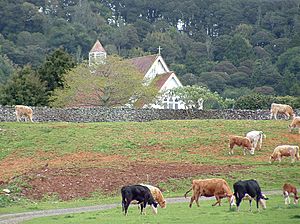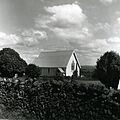Ōhaeawai facts for kids
Quick facts for kids
Ōhaeawai
|
|
|---|---|

St Michael's Church sits atop the pa site today in a pastoral setting
|
|
| Country | New Zealand |
| Region | Northland Region |
| District | Far North District |
| Ward | Kaikohe/Hokianga |
| Community | Kaikohe-Hokianga |
| Subdivision | Kaikohe |
| Electorates |
|
| Area | |
| • Total | 12.74 km2 (4.92 sq mi) |
| Population
(June 2023)
|
|
| • Total | 470 |
| • Density | 36.9/km2 (95.5/sq mi) |
Ōhaeawai is a small village in New Zealand's Far North District. It's located where two main roads, State Highway 1 and State Highway 12, meet. It's about 250 kilometers from Auckland. The town of Kaikohe is just 10.4 kilometers to the west. The beautiful Bay of Islands is also close by.
The name Ōhaeawai means 'place of thermal waters'. This name was given by the Ministry for Culture and Heritage in New Zealand.
Contents
History of Ōhaeawai
Ōhaeawai is known for its rich history. A very important event happened here in 1845. This was the Battle of Ohaeawai, fought during the Flagstaff War. It took place at a fortified village called a pā, which belonged to a chief named Pene Taui.
The battle was a big moment in New Zealand's history. It showed how strong the Māori defenses were against the British forces. Many people consider it a defeat for the British.
Taiamai and Sacred Sites
Near Ōhaeawai, there's a large volcanic rock called Taiamai. It stands about 3.5 meters high. In the past, this rock was a special place called an uruuru whenua. Travelers would say a charm and leave a small offering there. This was to show respect to the spirits of the place.
The area around Ōhaeawai is also a rich farming district. This is because of its fertile volcanic soil. The local Ngāpuhi people know this area as Tai-a-mai.
St. Michael's Church
In 1870, St. Michael's Anglican Church was built on the site of the old pā. This church is about 7.2 kilometers from Kaikohe. It's also 3.2 kilometers from the main Ōhaeawai township.
In 2018, the land around the church became a special place. Heritage New Zealand listed it as a wāhi tapu. This means it's a sacred place for the Ngāti Rangi hapū (a Māori sub-tribe). It also has great historical importance.
Ngawha Springs and Name Change
To the west of Ōhaeawai, you'll find Ngawha Springs. This is a small area with natural hot springs. These springs have healing properties. The Northland prison is also located in this area.
For a long time, the area was often called Ngawha. Some people believed the church's site was the true Ōhaeawai. They thought the modern township should be called Taiamai. However, in June 2019, the name Ōhaeawai was officially confirmed. The New Zealand Geographic Board made this decision.
Ōhaeawai's People
Statistics New Zealand describes Ōhaeawai as a rural settlement. It covers about 12.74 square kilometers. In 2023, Ōhaeawai had a population of 429 people. This was an increase of 30 people since 2018.
Who Lives in Ōhaeawai?
The population includes 204 males, 222 females, and 3 people of other genders. The average age, called the median age, was 38.2 years. This is similar to the national average.
- About 24.5% of the people were under 15 years old.
- 14.7% were between 15 and 29 years old.
- 46.2% were between 30 and 64 years old.
- 15.4% were 65 years or older.
People in Ōhaeawai come from different backgrounds. About 64.3% are European (Pākehā). Also, 53.1% are Māori. Smaller groups include Pasifika and Asian people.
Most people (98.6%) speak English. About 14.0% also speak the Māori language.
Work and Income
The median income in Ōhaeawai was $38,300. This is a bit lower than the national median income of $41,500.
- About 51.9% of people aged 15 and over work full-time.
- 14.8% work part-time.
- 4.6% are unemployed.
Marae in Ōhaeawai
A marae is a very important meeting place for Māori people. It's a central part of Māori culture and community life. In the Ōhaeawai area, there are three important Ngāpuhi marae.
- Parawhenua Marae: This marae is connected to several hapū (sub-tribes). These include Ngāti Hineira, Ngāti Korohue, Te Uri Taniwha, and Te Whanauwhero.
- Rāwhitiroa or Te Ahuahu Marae: This marae is linked to Ngāti Hineira, Te Kapotai, Te Popoto, and Te Uri Taniwha.
- Ngawha Marae: This marae is connected to the Ngati Rangi hapū.
In 2020, the New Zealand Government helped upgrade the Parawhenua Marae. They provided $499,093 to improve the facilities. This project also created 10 jobs for local people.
Education in Ōhaeawai
Ōhaeawai has its own school, called Ohaeawai School. It's a primary school for students in years 1 to 6. The school has about 133 students. Ohaeawai School has been teaching children since 1874.
Images for kids


